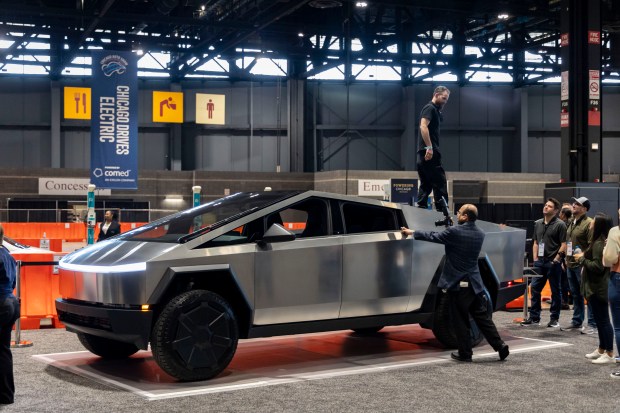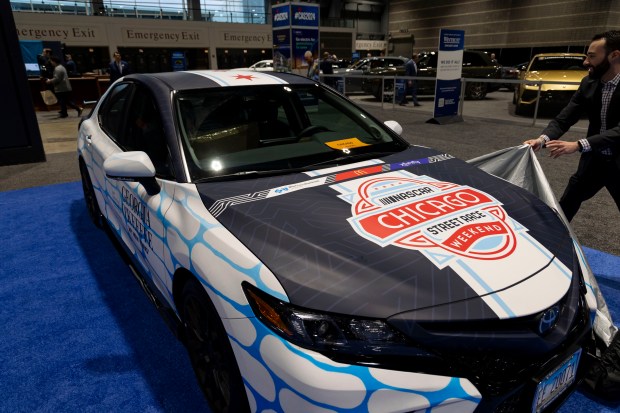The annual Chicago Auto Show opens Saturday at McCormick Place, and for the first time in nearly a century, one of the Big Three automakers will not be there.
Tightening its belt in the wake of the protracted United Auto Workers strike last fall, Stellantis decided to skip the auto show entirely, pulling its Jeep, Chrysler, Dodge, Fiat and Ram vehicles off the floor and ending the two-decade run of the popular Camp Jeep test track.
In the wake of the Stellantis exit, the auto show has consolidated exhibits down from two halls into one, but packed the space with an expansive lineup of brands, plenty of interactive exhibits and a robust lineup of electric vehicles, including show newcomers Tesla and Lucid.
Chicagoans will have their first chance to kick the giant tires of the long-delayed Tesla Cybertruck, a futuristic-looking EV that began rolling off the production line last fall. They can also get their first look at the digitally refreshed 2025 Ford Explorer, which is made in Chicago.
Homegrown Rivian, which makes EV trucks and SUVs in downstate Normal, remains a no-show at this year’s auto show.
Electric vehicles will be center stage once again this year, with a dedicated EV test track and a slew of new offerings. But there may be a few bumps in the road ahead for EV manufacturers, who are facing slowing demand and their own potential labor strife.
Edmunds is projecting 15.7 million new cars to be sold in 2024, up from 15.5 million last year. EV market share is expected to reach 8% of total new vehicle sales in 2024, up from 6.9% last year, according to the car shopping website.
EVs topped the 1 million sales mark in the U.S. last year for the first time.
But there are signs, despite federal, state and manufacturer incentives, that EV adoption has decelerated as consumers grapple with spotty charging infrastructure, range anxiety and other logistical hurdles to taking the plunge.
VW America CEO Pablo Di Si, an Argentine who attended Loyola University in Chicago during the 1990s, returned to town for the auto show, touting the brand’s ambitious strategy to offer a lineup of 25 electric vehicles planned by 2030.
EV models on display included the ID.4, which is produced at VW’s plant in Chattanooga, Tennessee, and sold 75,000 units in North America last year. A quirkier entry is the VW.Buzz, a retro electrified version of the VW bus that was favored by wandering hippies during the 1960s.
The VW.Buzz is expected to hit the roads later this year.
Di Si expects initial demand for the VW.Buzz to outstrip supply. And he said if they could have built more ID.4s last year, they would have sold them. Longer term, as manufacturers increase the number of offerings, EV market share will continue to grow, but how quickly that ramps up remains to be seen, Di Si said.
“In the last couple of years, the growth of EVs has been pretty dramatic,” Di Si said. “This year, the growth continues, but not as intensive as the last couple years. Time will tell.”
While EV adoption remains a variable, VW and other nonunion manufacturers may also face some labor issues in the coming year.
In the aftermath of the six-week strike against the Big Three automakers, UAW President Shawn Fain said the union intends to target nonunion plants, including EV manufacturers, to get them to join. Organizing efforts are underway at Toyota, Honda, Hyundai, Tesla, Nissan, BMW, Mercedes-Benz, Subaru, Volkswagen, Mazda, Rivian, Lucid and Volvo plants in the U.S.

Di Si was tapped to head up North American operations in 2022, and moved to Chattanooga, site of the German automaker’s only U.S. plant. More than 4,000 nonunion autoworkers build the all-electric ID.4 there, as well as the combustion-engine Atlas SUV.
On Tuesday, the UAW announced a majority of workers at the plant had signed cards to join the union, making it the first of the recently targeted nonunion plants to support the organizing effort.
“Obviously, we respect the right of freedom,” Di Si said. “We also emphasize providing correct information to the employees so they can make their own informed decisions.”
With the 25% increase in base wages and the reinstatement of cost-of-living adjustments, UAW assembly workers will make more than $40 an hour by the end of the new four-year labor agreement in 2028.
Assembly workers at the VW plant start at $23.40 per hour, scaling up over four years to $32 per hour, Di Si said.
The UAW is also seeking to unionize Rivian, which launched production in September 2021 and now has about 7,000 employees building electric pickup trucks, SUVs and delivery vans for Amazon and AT&T in a formerly vacant, 3.3 million-square-foot auto plant in downstate Normal.
Last year, Rivian produced 57,232 vehicles.
In 2022, the starting salary for assembly workers at Rivian’s plant in Normal was $20 per hour. The starting rate has since been bumped up to $22 per hour, according to spokeswoman Kelli Felker.
Meanwhile, the Chicago Assembly Plant, where more than 4,600 UAW members participated in a one-month strike before a labor deal was reached with Ford, has something of a starring role at the auto show this year.
Ford is unveiling the 2025 Explorer SUV, which is built exclusively at the plant on the city’s Southeast Side. The popular SUV is undergoing a significant refresh focused on simplifying the build, improving production quality and enhancing the digital driving experience.
“It’s a pretty sizable change,” said Jim Baumbick, Ford’s vice president of product development operations and quality. “It’s a major refresh.”
The biggest changes are inside, where the SUV was designed to connect with digital-native millennials starting to take their families on road trips. The new Explorer includes a large 13-inch touchscreen display on the dashboard and enough USB ports (8 across three rows) to keep an entire kids soccer team plugged in during the drive.
It is also the first Explorer to offer optional BlueCruise hands-free driving, which can take the wheel on designated highways — traffic and weather-permitting.
The new model is expected to begin shipping in the second quarter, with customers able to place orders beginning in February. There will be some shutdowns in production at the nearly century-old Chicago Assembly Plant to gear up and switch over to the new build, Baumbick said.
After three years of pandemic disruption that saw postponements, downsizing and a special outdoor summer edition, the Chicago Auto Show returned last year to a full-size exhibition covering two halls at McCormick Place.
The absence of Stellantis precipitated jamming the rest of the exhibitors into slightly expanded floor space in the South Hall, sans one prominent attraction for attendees.
The Camp Jeep test track, a challenging indoor, off-road course that featured a 28-foot “mountain” climb to allow visitors to ride along in the brand’s rugged 4×4 vehicles, had been an integral part of the Chicago Auto Show for nearly 20 years.
The 2024 show still has three indoor test tracks, including Ford Bronco, Hyundai Ioniq and the Chicago Drives Electric course, which will feature eight EV brands. For the more daring, there’s Honda’s foldable Motocompacto electric scooter, which has its own mini test track, replete with carefully cleaned helmets to use.
In addition, visitors can participate in outdoor test drives with Ford, Kia and Subaru.

Also on display is the Toyota Camry pace car for this summer’s return of the NASCAR Chicago Street Race in Grant Park. The vehicle is adorned with a custom wrap promoting the upcoming Georgia O’Keeffe exhibit at the Art Institute.
While the auto show has plenty of high-tech glitz and glamour, one thing in short supply may be at the top of most car-shoppers lists — affordability.
“About half of people are planning on spending under $30,000,” said Rebecca Lindland, senior director of industry data and insights at Chicago-based Cars Commerce, formerly known as Cars.com. “The challenge is that only about 12% of new cars are priced under $30,000.”
Lindland said the auto show nonetheless remains a “great opportunity to get your butt in the seat” of a lot of cars in one place.
Launched in 1901, the Chicago Auto Show went on hiatus during World War II as auto production was curtailed, but it hasn’t missed a year since it resumed in 1950. The 116th Auto Show runs Saturday through Feb.19 at McCormick Place. Tickets are $17 for adults.
rchannick@chicagotribune.com





